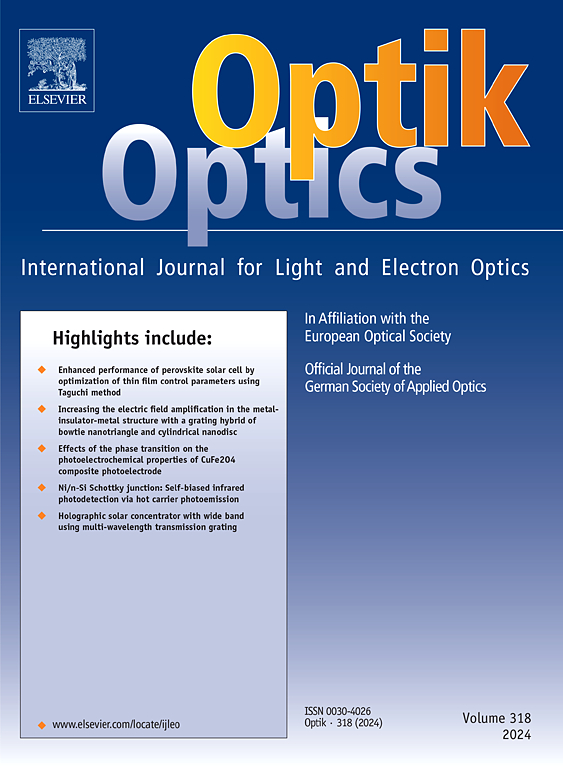镍/n-硅肖特基结:通过热载流子光发射实现自偏压红外光探测
IF 3.1
3区 物理与天体物理
Q2 Engineering
引用次数: 0
摘要
在金属半导体结上产生基于内部光发射的热电子为硅基亚带隙近红外光电探测器带来了巨大潜力。在这项工作中,我们利用脉冲激光沉积技术设计了一个简单的镍硅肖特基结,并进行了实验和理论分析。为了降低制造的复杂性和成本,我们在 n 型硅上使用了平面镍薄膜。我们对镍薄膜的厚度进行了优化,以改善镍/硅界面附近的吸收和热电子生成。我们使用传递矩阵法测量和计算反射率,以量化厚度对 EQE 的影响。我们还计算了随厚度变化的吸收曲线,以估计结点附近的热电子产生情况。我们研究了镍/n-硅肖特基光电探测器在黑暗条件下以及 1200 纳米和 1300 纳米光照条件下的电流-电压特性。在自偏压条件下,12 nm Ni 厚度的光电二极管在 1200 nm 和 1300 nm LED 光照射下的响应率分别为 0.124 mA/W 和 0.069 mA/W。此外,我们还使用了一个全面的理论模型来量化平面镍/硅热载流子的产生和发射效率。我们相信,所提出的兼容互补金属氧化物半导体且结构简单的镍/硅肖特基光电探测器将在硅基光电子市场上具有潜在的应用前景。本文章由计算机程序翻译,如有差异,请以英文原文为准。
Ni/n-Si Schottky junction: Self-biased infrared photodetection via hot carrier photoemission
Internal photoemission-based hot electron generation at metal-semiconductor junctions holds significant potential for silicon-based sub-bandgap NIR photodetectors. In this work, we designed a simple nickel-silicon Schottky junction using the pulsed laser deposition technique and performed both experimental and theoretical analyses. To reduce the complexity of fabrication and lower costs, we used a planar nickel thin film on top of n-type silicon. The thickness of the nickel thin film was optimized to improve absorption and hot electron generation near the Ni/Si interface. We measured and calculated reflectance using the transfer matrix approach to quantify the effect of thickness on EQE. We also calculated the thickness-dependent absorption profile to estimate hot electron production near the junction. The current-voltage characterization of Ni/n-Si Schottky photodetector was investigated under the dark conditions as well under 1200 nm and 1300 nm light illumination. Under self-bias conditions, a photodiode with a 12 nm Ni thickness exhibits responsivity of 0.124 mA/W and 0.069 mA/W under illumination from 1200 nm and 1300 nm LED light, respectively. Furthermore, we used a comprehensive theoretical model to quantify the planar Ni/Si hot carrier generation and emission efficiency. and experimentally validated the calculated EQEs with the fabricated device. We believe the proposed complementary metal-oxide-semiconductor-compatible and simply structured Ni/Si Schottky photodetector will have potential applications in the silicon-based optoelectronics market.
求助全文
通过发布文献求助,成功后即可免费获取论文全文。
去求助
来源期刊

Optik
物理-光学
CiteScore
6.90
自引率
12.90%
发文量
1471
审稿时长
46 days
期刊介绍:
Optik publishes articles on all subjects related to light and electron optics and offers a survey on the state of research and technical development within the following fields:
Optics:
-Optics design, geometrical and beam optics, wave optics-
Optical and micro-optical components, diffractive optics, devices and systems-
Photoelectric and optoelectronic devices-
Optical properties of materials, nonlinear optics, wave propagation and transmission in homogeneous and inhomogeneous materials-
Information optics, image formation and processing, holographic techniques, microscopes and spectrometer techniques, and image analysis-
Optical testing and measuring techniques-
Optical communication and computing-
Physiological optics-
As well as other related topics.
 求助内容:
求助内容: 应助结果提醒方式:
应助结果提醒方式:


